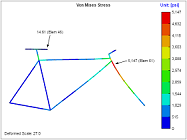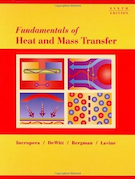Heat Transfer Terminology
This page provides the chapter on heat transfer terminology from the "DOE Fundamentals Handbook: Thermodynamics, Heat Transfer, and Fluid Flow," DOE-HDBK-1012/2-92, U.S. Department of Energy, June 1992.
Other related chapters from the "DOE Fundamentals Handbook: Thermodynamics, Heat Transfer, and Fluid Flow" can be seen to the right.
Heat Transfer Terminology
To understand and communicate in the thermal science field, certain terms and expressions must be learned in heat transfer.
Heat and Temperature
In describing heat transfer problems, students often make the mistake of interchangeably using the terms heat and temperature. Actually, there is a distinct difference between the two. Temperature is a measure of the amount of energy possessed by the molecules of a substance. It is a relative measure of how hot or cold a substance is and can be used to predict the direction of heat transfer. The symbol for temperature is T. The common scales for measuring temperature are the Fahrenheit, Rankine, Celsius, and Kelvin temperature scales.
Heat is energy in transit. The transfer of energy as heat occurs at the molecular level as a result of a temperature difference. Heat is capable of being transmitted through solids and fluids by conduction, through fluids by convection, and through empty space by radiation. The symbol for heat is Q. Common units for measuring heat are the British Thermal Unit (Btu) in the English system of units and the calorie in the SI system (International System of Units).
Heat and Work
Distinction should also be made between the energy terms heat and work. Both represent energy in transition. Work is the transfer of energy resulting from a force acting through a distance. Heat is energy transferred as the result of a temperature difference. Neither heat nor work are thermodynamic properties of a system. Heat can be transferred into or out of a system and work can be done on or by a system, but a system cannot contain or store either heat or work. Heat into a system and work out of a system are considered positive quantities.
When a temperature difference exists across a boundary, the Second Law of Thermodynamics indicates the natural flow of energy is from the hotter body to the colder body. The Second Law of Thermodynamics denies the possibility of ever completely converting into work all the heat supplied to a system operating in a cycle. The Second Law of Thermodynamics, described by Max Planck in 1903, states that:
It is impossible to construct an engine that will work in a complete cycle and produce no other effect except the raising of a weight and the cooling of a reservoir.
The second law says that if you draw heat from a reservoir to raise a weight, lowering the weight will not generate enough heat to return the reservoir to its original temperature, and eventually the cycle will stop. If two blocks of metal at different temperatures are thermally insulated from their surroundings and are brought into contact with each other the heat will flow from the hotter to the colder. Eventually the two blocks will reach the same temperature, and heat transfer will cease. Energy has not been lost, but instead some energy has been transferred from one block to another.
Modes of Transferring Heat
Heat is always transferred when a temperature difference exists between two bodies. There are three basic modes of heat transfer:
Conduction involves the transfer of heat by the interactions of atoms or molecules of a material through which the heat is being transferred.
Convection involves the transfer of heat by the mixing and motion of macroscopic portions of a fluid.
Radiation, or radiant heat transfer, involves the transfer of heat by electromagnetic radiation that arises due to the temperature of a body.
The three modes of heat transfer will be discussed in greater detail in the subsequent chapters of this module.
Heat Flux
The rate at which heat is transferred is represented by the symbol \( \dot{Q} \). Common units for heat transfer rate is Btu/hr. Sometimes it is important to determine the heat transfer rate per unit area, or heat flux, which has the symbol \( \dot{Q}'' \). Units for heat flux are Btu/hr-ft2. The heat flux can be determined by dividing the heat transfer rate by the area through which the heat is being transferred.
where:
| \( \dot{Q}'' \) | = | heat flux (Btu/hr-ft2) |
| \( \dot{Q} \) | = | heat transfer rate (Btu/hr) |
| A | = | area (ft2) |
Thermal Conductivity
The heat transfer characteristics of a solid material are measured by a property called the thermal conductivity (k) measured in Btu/hr-ft-°F. It is a measure of a substance's ability to transfer heat through a solid by conduction. The thermal conductivity of most liquids and solids varies with temperature. For vapors, it depends upon pressure.
Log Mean Temperature Difference
In heat exchanger applications, the inlet and outlet temperatures are commonly specified based on the fluid in the tubes. The temperature change that takes place across the heat exchanger from the entrance to the exit is not linear. A precise temperature change between two fluids across the heat exchanger is best represented by the log mean temperature difference (LMTD or ΔTlm), defined in Equation 2-2.
where:
| ΔT2 | = | the larger temperature difference between the two fluid streams at either the entrance or the exit to the heat exchanger |
| ΔT1 | = | the smaller temperature difference between the two fluid streams at either the entrance or the exit to the heat exchanger |
Convective Heat Transfer Coefficient
The convective heat transfer coefficient (h), defines, in part, the heat transfer due to convection. The convective heat transfer coefficient is sometimes referred to as a film coefficient and represents the thermal resistance of a relatively stagnant layer of fluid between a heat transfer surface and the fluid medium. Common units used to measure the convective heat transfer coefficient are Btu/hr - ft2 - °F.
Overall Heat Transfer Coefficient
In the case of combined heat transfer, it is common practice to relate the total rate of heat transfer (\( \dot{Q} \)), the overall cross-sectional area for heat transfer (Ao), and the overall temperature difference (ΔTo) using the overall heat transfer coefficient (Uo). The overall heat transfer coefficient combines the heat transfer coefficient of the two heat exchanger fluids and the thermal conductivity of the heat exchanger tubes. Uo is specific to the heat exchanger and the fluids that are used in the heat exchanger.
where:
| \( \dot{Q} \) | = | the rate heat of transfer (Btu/hr) |
| Uo | = | the overall heat transfer coefficient (Btu/hr - ft2 - °F) |
| Ao | = | the overall cross-sectional area for heat transfer (ft2) |
| ΔTo | = | the overall temperature difference (°F) |
Bulk Temperature
The fluid temperature (Tb), referred to as the bulk temperature, varies according to the details of the situation. For flow adjacent to a hot or cold surface, Tb is the temperature of the fluid that is "far" from the surface, for instance, the center of the flow channel. For boiling or condensation, Tb is equal to the saturation temperature.



